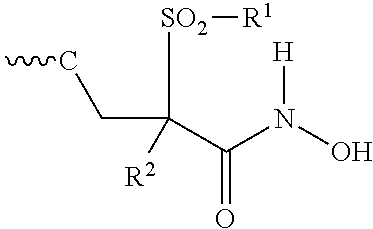Isoxazole derivatives useful as antibacterial agents
a technology of isoxazole and derivatives, applied in the direction of antibacterial agents, biocide, heterocyclic compound active ingredients, etc., can solve the problems of limiting treatment options, affecting the survival rate of bacteria, and affecting the effect of lipid a biosynthesis
- Summary
- Abstract
- Description
- Claims
- Application Information
AI Technical Summary
Problems solved by technology
Method used
Image
Examples
preparation 1
Ethyl 2-methyl-2-(methylsulfonyl)hex-5-ynoate and individual enantiomers (R) and (S)
[0198]
Step A)
Ethyl 2-(methylsulfonyl)propanoate
[0199]Sodium methyl sulfinate (103 g, 937 mmol) was combined with the ethyl 2-chloropropionate (109 g, 892 mmol) in ethanol (350 mL) in a 500 mL one neck round bottom flask. The reaction was heated to 77° C. for 20 h, and then allowed to cool to room temperature. Solids were removed by filtration through celite, and the filter pad was washed with ethanol. The combined filtrates were concentrated under reduced pressure. The crude product was suspended in diethyl ether (250 mL), and solids were removed by filtration. The filtrate was concentrated under reduced pressure to afford the title compound as a pale yellow oil (51 g, 73%). 1H NMR (400 MHz, CHLOROFORM-d) δ1.32 (t, J=7.05 Hz, 3H) 1.67 (d, J=7.47 Hz, 3H) 3.05 (s, 3H) 3.83-3.92 (m, 1H) 4.18-4.37 (m, 2H).
Step B)
Ethyl 2-methyl-2-(methylsulfonyl)hex-5-ynoate
[0200]Sodium hydride (60% dispersion in mineral ...
preparation 2
Ethyl 5-(hydroxyimino)-2-methyl-2-(methylsulfonyl)pentanoate and individual enantiomers (R) and (S)
[0203]
Step A)
Ethyl 2-methyl-2-(methylsulfonyl)hex-5-enoate
[0204]The title compound (8.0 g, 46%) was prepared from ethyl 2-(methylsulfonyl)propanoate (13.3 g, 74.1 mmol) and 4-bromobut-1-ene (10.0 g, 74.1 mmol) by following the procedure described for the synthesis of ethyl 2-methyl-2-(methylsulfonyl)hex-5-ynoate (Preparation 1, Step B). MS (GCMS) m / z 235 (M+1). 1H NMR (400 MHz, CHLOROFORM-d) δ1.33 (t, J=7.17 Hz, 3H) 1.63 (s, 3H) 1.91-2.08 (m, 2H) 2.13-2.29 (m, 1H) 2.32 (d, J=7.51 Hz, 1H) 3.05 (s, 3H) 4.29 (q, J=7.06 Hz, 2H) 4.95-5.16 (m, 2H) 5.67-5.93 (m, 1H)
Chiral separation of ethyl-2-methyl-2-(methylsulfonyl)hex-5-enoate
[0205]The racemic material (12.2 g) was resolved using flash chromatography under the conditions presented in Table 2 (below) to provide enantiomer 1 (4.2 g, [α]58920=−3.7°, 99% enantiomeric purity) and enantiomer 2 (4.9 g, [α]58920=+2.9°, 99% enantiomeric purity). E...
preparation 3
1-Ethynyl-2-fluoro-3-methoxybenzene
[0209]
[0210]Potassium carbonate (3.6 g, 26.0 mmol) and dimethyl-1-diazo-2-oxopropylphosphonate (2.4 mL, 15.6 mmol) were added sequentially to a solution of 2-fluoro-3-methoxybenzaldehyde (2.0 g, 13.0 mmol) in methanol (100 mL), and the reaction was allowed to stir at room temperature for 16 h. After concentrating the reaction mixture under reduced pressure, the crude material was purified by flash chromatography (40 g silica gel column, 0-40% gradient ethyl acetate in hexanes) to provide a clear colorless oil (1.8 g, 92%). MS (GCMS) m / z 150. 1H NMR (400 MHz, CHLOROFORM-d) δ3.31 (d, J=0.78 Hz, 1H) 3.90 (s, 3H) 6.93-7.11 (m, 3H).
PUM
| Property | Measurement | Unit |
|---|---|---|
| temperature | aaaaa | aaaaa |
| temperature | aaaaa | aaaaa |
| volume | aaaaa | aaaaa |
Abstract
Description
Claims
Application Information
 Login to View More
Login to View More - R&D
- Intellectual Property
- Life Sciences
- Materials
- Tech Scout
- Unparalleled Data Quality
- Higher Quality Content
- 60% Fewer Hallucinations
Browse by: Latest US Patents, China's latest patents, Technical Efficacy Thesaurus, Application Domain, Technology Topic, Popular Technical Reports.
© 2025 PatSnap. All rights reserved.Legal|Privacy policy|Modern Slavery Act Transparency Statement|Sitemap|About US| Contact US: help@patsnap.com



